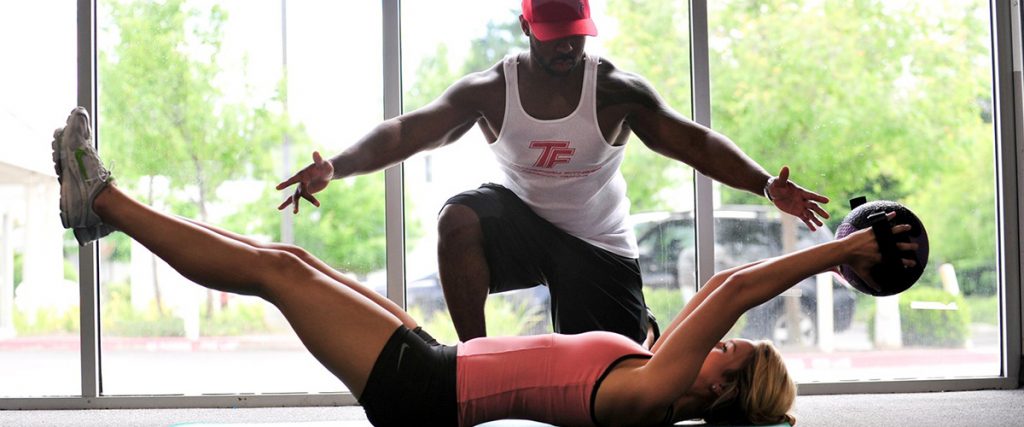When someone says they’re a personal trainer, what comes to mind? Do you envision them tanned and toned sipping green smoothies every morning, or do you see a drill sergeant barking out commands as their clients frantically try to do one last squat?
Let’s set the record straight: Most trainers don’t do this, look like this and will never want to see you sweat, at least not sweat because you’re petrified.
Becoming a personal trainer is, well, personal. Some people want to devote their lives to staying fit, others want to find new and innovative ways to help others live their healthiest life possible. But regardless of their motivation, people still stereotype fitness trainers and think we are all the same, all the way down to our six-pack abs.
We Know it All
Becoming a trainer isn’t only about earning a certificate. In fact, a lot of personal trainers are often duped into spending money they really didn’t need to. Staying at the forefront of fitness means learning new exercise programs to deliver the results our clients expect. That means spending money for continuing education, attending fitness seminars and even trying out health and wellness supplements to make sure they are legit.

We all Have Six-Pack Abs
Most trainers don’t live to eat only baked chicken with broccoli. We love to indulge just like you, which means paying for it later. Yes, we stay in shape and work hard to carve out our abs, but it’s not easy. Just like you, we show up and put in the work.
We are Paid Salary
Yes, some trainers will be salaried but for the most part, we get paid for services rendered. Whether we own our business or work out of multiple gyms, we get paid for what we do.
We Like Seeing You In Pain
Our goal is to help you get stronger and look better . It is not our intention to make you feel sore by any means. If you’re feeling sore from the training, it’s probably because you’re using muscles you haven’t used at all or they’re being used in different ways. This may help with building muscle, but there is no need for pain.
In fact, the more intense the pain is, the less high-intensity sessions you’ll be able to do. Muscle gain, or hypertrophy, can occur three ways; muscle damage, mechanical stress and metabolic stress. A diligent trainer will monitor the soreness because it shows how your recovery mechanics work.

Our Job is to Help You Lose Weight
Even though losing weight and being fit are worthy goals, they aren’t exactly SMART goals. SMART stands for specific, measurable, attainable, relevant and timely. If you don’t incorporate these five components, you are most likely to fail in your attempt. With the business of personal training, we aim to help you make SMART goals. For example, having a goal of losing weight should always have a reason behind it. Whether it’s to set a good example for your children, put on your favorite outfit or to impress those critical in-laws, always ask yourself what your goal is for getting personal training.
Keeping Your Muscles Confused
It’s a known fact that confusing your body isn’t a great way to be fit. With that said, personal training isn’t meant to constantly teach you new things. It’s to teach you how to do things better. The most important movements you’re able to do in a gym usually come naturally. Maybe you still know how to do them or your body simply forgot during the years of inactivity. Regardless, it’s essential to learn how produce as much tension as you can through a proper movement. The business of personal training isn’t about teaching fancy exercises. It’s about teaching you how to feel throughout a movement.
The Perfect Workout is Only an Hour-Long
Having an hour-long workout is only meant to keep you active. In fact, a lot of trainers despise one-hour training sessions. Most workout protocols can change depending on what the goal of the session is. For example, a metabolic workout may take only 20 minutes, while a muscle-gain exercise can be as long as an hour and a half. Should a trainer end a session in less than a designated time, that doesn’t mean that they’re slacking on the job. It was because it was the ideal time to achieve the goal of the session.
Your Workout is What’s Most Important
If you’re feeling as if the trainer you hired a trainer that gives you a number of exercises and stands over you, then you’re being ripped off. First, a good trainer will try to make you want to do the program and the workouts that come with it. Second, it is also a trainer’s job to make sure that you’re looking forward to, confident and overall comfortable with going your exercise program.
From the outside looking in, the life of a fitness may seem like glitz, glamour and the easiest job in the world. Unfortunately, far too many people enter the field because they want to make a fast buck. Being a trainer isn’t about making fast cash;it’s about doing what you love, standing behind your fitness values and helping others achieve their health and wellness goals because you genuinely care.
Debunking personal training myths isn’t always easy. Even with the increase of top quality talent entering the industry and proving that the business of personal training is more than down protein bars, there are still skeptics. Our advice to you? Don’t let the hype dissuade you working with a trainer. Take the time to find a trainer that you feel comfortable with. Know that it’s okay if you don’t think we are on the same page as you. We might even refer to someone whose training style aligns better with your fitness goals.




